So 13th Age, as you may have read, revolutionized my way of looking at fantasy settings and cooperative storytelling within them.
The concept of Icons intended as powers that have clear (or murky, but definedly so) relationships with each other, and with which the player characters can have in their turn defined relationships with, kind of stated the obvious about world-building, but in a "why haven't I thought it before" kind of way.
My own "infinite project" named World of Cthon started as an alternative cosmology for D&D. The key idea was putting all the planes of existence inside a single material world, with defined spatial and temporal relationships with each other. That is to say: Heaven is a place on earth. And Hell too.
Such a "pocket-size" cosmology naturally implies an "assumed setting". That is, it's not just a guideline regarding planes, but it strongly suggests a story, and stories have characters.
The most influential of these characters are the three major families of gods of Cthon, that are beings sometimes defined as godly, sometimes not, throughout the whole history of D&D (if keeping the original D&D flavor).
In what I wanted to be a heads-up to real anthropology, the three families of gods represent/define three periods of time.
- We have the "Elder Gods", that are the masters of the First Age: beings of chaos for an era of chaos, mostly evil from a human(oid) point of view, also because in this age, humans and their relatives are primitive and powerless, thus suggesting a world dominated by immense evil powers that all play against their survival, much like the first generation of gods of most real-world pantheons (i.e. Kronos and the Titans in Greek mythology). This is the implied anthropological notion, whereas in game terms, it's a cool way to place beings such as "Old Ones", demon princes and "primordials "of destruction and chaos in a time frame that preceded everything (allowing for typical plots of "ancient evil unearthed" in following game-time eras), and also conveniently puts all of these terrible beings deep underground, far from the frail civilizations of later-on in game history.
- Then come the "Titans", the second generation of gods. These beings are mostly elemental in nature and start being more abstract and less bent on wanton destruction, compared to the first ones. All the typical real-world mythology pantheons' gods belong here: a deity of thunder, one of fire, one of forests and so on. This allows a focus on demi-humans, most notably Dwarves/Gnomes and Elves, as races favored by elemental gods, obviously those of Stone and Forest respectively. Humans also start to thrive, but at a slower rate: they arrive at the end of the age (probably also ending it), when Elves and Dwarves have already touched their apex and are already declining thanks to inevitable wars and feuds. The implied anthropological notion here is that civilization is allowed to come up for humanoids, for the first time, and the gods reflect this, being kind of sympathetic towards mortals, but still capricious. It's a golden age of abundance, but with the constant danger of godly wrath or even godly whims. Sons and daughters of mortals and gods also abound, and the "trickster gods" play a key role in humanity's rise...
- The third generation is that of "Celestial" gods. These are not even classifiable completely as "beings" and are the most immaterial players in this world's scene. It is said they could be mortal souls ascended to a new state of godhood, or perhaps even the essence of principles and dogmas taken godly form. Civilization at this point is in some kind of a dark age compared to the second age. Humans prosper in numbers, but their level of understanding of the world has decreased, and the gods and their attached religions may be responsible for it, or an image of it. Sacred wars abound, and world-spanning churches clash with each other, with claims of heresy and blasphemy being equivalent to war declarations. In game terms, these are the gods that are most on the "Lawful" side, and this comes with all the good and the bad of it. While the First age Elder gods were material forces of chaos, these ones are immaterial forces of law. With the occasionally mingling and occasionally aloof second age gods being a lost (or perhaps just forgotten) neutral middle term.
- The Angelic Chorus. This is strange. I wouldn't have thought I could have started with such a thing. But yes, angels must have a big role in the Third Age, and it's surprisingly interesting and even logical to have them as independent players. They are the intermediaries between the Celestial Gods and the mortals. And their alignment, as such, is not well defined. They are definitely Lawful, but they could be Good or Evil, depending on the actual power they serve or favor. Making them a faction of their own also poses interesting questions on any possible hidden agenda of these beings, separate from that of the gods that they -claim- to serve...
- The Church. Another strange choice. There are many churches in the Third Age, so why calling one of these "The Church"? Because it claims to be the only true one, of course..! This is the typical Lawful Neutral power that wants others to believe they are the Good, but is instead a god (yes, there's a god attached, to make it more fantastical) that is manipulative, all about control of the mortals, seen as masses that must not question the higher powers. Making this god-organization like this allows for interesting interactions with both the subsequent Icons, which are truly morally significant.
- The Light. A typical god of good. This god has a church, but it's considered heretic by The Church, so they are persecuted and basically covert, speaking of followers. The god itself is also some kind of a recluse. being the least Lawful of the Good powers (tending to Neutral Good, in D&D alignment terms), it believes in non-violence and would never fight the other powers for dominance, since one of the few lawful dogmas it has, it's exactly the one of solving conflicts through love and not war. Making this god separate from the one behind The Church, or at least *probably separate* is another plot-device in play. Maybe some parts of The Church actually follow The Light. Maybe the actual god behind them is one and the same, BUT... The Church as an organization and as the god behind it has been corrupted by something else, such as...
- The Devil. Plain and simple. In this age, absolutes reign. And if you don't follow The Church or The Light, you probably follow The Devil. In that "probably" though, lies a lot of plot-spawning power. There is a true devilish power, but is it actually localized within the devil-worshiping cults? A good quote that I can't actually quote roughly says: "the first thing the devil would do is making others believe that the god of good is the devil and that he is the god of good". So it's all ambiguous. Another interesting thing is that, in Cthon, a being such as The Devil would be a material being. So maybe the actual devil-worshiping cults are worshiping an entity from a time in which powers were material. Maybe such a being is aiming at becoming a "new" celestial deity, transcending physical form perhaps thanks to the worship of thousands or hundreds of thousands mortal souls. A lot of questions, but The Devil answers none...
- The Greatest. Another "modest" god/church... Along the lines of The Church, claiming to be what it is with its very name, The Greatest claims to be... The Greatest. This is another ambiguous but surely very Lawful-oriented power that aims to be the main "sacred war adversary", in a fashion that we all know about... It adds some depth because again, there are sometimes very good implied relationships with the principles of The Light, but does that mean there's a connection between these gods or not? And does that mean that they are allies or not? Basically, The Greatest and The Church are two sides of the same coin... But will it really be the same, behind closed doors? Another plot-device ready.
- The Magister. The role of the "god of magic" fused with "science and technology" fused with "dark ages academical knowledge and thus ignorance". This is a god and organization (basically a world-spanning university-like organization) aiming at distributing knowledge, but knowledge that is often very partial, even if not completely distorted and censored such as that of The Church. The relationship with the latter is obviously bad, and this allows sometimes for brief allegiances with The Greatest, which is in some aspects "newer" and thus a bit more "innovative" than The Church. However, even The Greatest sometimes sees the hand of The Devil in the works of magic and science of The Magister, so things can get rough with all sides. However, there is a divinity even behind this "rational power", and is in fact a god of magic. Some say the soul of the very first Wizard, combined with a those of a group of ancient philosophers.
- The Two-Faced. Even the Third Age needs a "trcikster god"... Or is it really from the Third Age..? Being dual by nature, nothing can be certain with the Two-Faced. The D&D god Olidammara represents this deity very well. It's basically a deity of luck, travel, deceit, shadows, and arts, all at the same time. It's what's left of many divine portfolios, in previous times covered by different deities, in an age in which most gods shun all of these concepts. And similarly, while all other gods try to be "the only true one", The Two-Faced stays in the shadows that he/she represents, not taking part in any of the big, world-spanning and heresy-hunting conflicts. It is said it's actually two or more deities in one, perhaps the companions of the original Wizard behind the Magister, when they were all mortal adventurers. As such, the Two-Faced is a bit Ranger, a bit Rogue, a bit Bard, a bit Cleric, a bit Fighter and so on. It's the "default" deity of those that are tired of the great powers and want to be more individualistic, instead of part of organized churches and creeds. Its sanctuaries are hidden even better than those to The Devil, and are of course considered "pagan" by the bigger powers, although for some reason they are not persecuted or obstructed much. Evidently, something ties The Two-Faced with The Magister, and The Magister with The Church and The Greatest, perhaps even with The Light. Or is there also a connection with The Devil after all? All can be, once again...
- The Ethereal. A mysterious "Intermediate power" a bit like the Angelic Chorus, this deity/power is responsible for the Third Age presence of undeath, lingering spirits, phantoms, and perhaps even worse... Or better. The cults directly tied to the Ethereal are many but politically insignificant and largely unknown. And each one of them has a different theory about this being/power. Some of them even say that it's the "father" of all other celestials, some say the source of their power, some just some kind of "divine vessel" necessary for their existence, and some don't care at all, but become believers in front of the terrorizing truths of the existence of undeath in the world. All the "higher" powers oppose undeath, but there's no word of anyone actually opposing The Ethereal itself. The Magister's most knowledgeable adepts think that The Ethereal is not actually a deity, but those that follow The Two-Faced clues about the Second Age, find out that there may be some connection between the previous god of death and the Ethereal. Whatever it is, it probably has an agenda. Or maybe not.
- The Dwarf God. Still present in the Thrid Age, the dwarves and their god are in a conflicted relationship with basically all other powers: never approving everything, sometimes opposing completely. Naturally inclined to be demon-hunters or warders (since they delve deep beneath the earth, were actual demons live), the dwarves are surely enemies of The Devil, whatever that may really mean, and view The Ethereal as something best left alone and afar. The Two-Faced is a trickster, thus not more reliable than the hated Elf God, but for some (good) reason, the relationship seems to be good from the Two-Faced side, so things are still ok. The Dwarf God admired the organization and strictness of The Church and The Greatest, sometimes even conflicted (and thus neutral) between the two, and The Light is another appealing power for many, but it's considered too "far-fetched". The most interesting connection is that with The Magister. While not trusting the magical side of it, the knowledge-delving and technical-oriented sides are extremely well-appreciated by the Dwarf God. The problem is: how much does The Dwarf God or do the dwarves matter in the Third Age? As many other things, they matter as much as time is dedicated to them. A large event may make their relevance swing both ways in meaningful ways, so basically this becomes one of those icons that the player character will kind of maneuver with their actions.
- The Elf God. Pretty much like the Dwarf God. But inverted in colors. Black and white are things they agree on, but that's it. All colors are different. Great relationship with The Two-Faced, also some strange connection with The Ethereal, an opposite relationship with The Magister (loving the magical side, not much the technical one), and similarly neutral views on the higher powers and organizations. Another conflicted/strange relationship is the one with the Angelic Chorus. They seem to be graceful, something that for the elves and their god has nearly moral value, but where do they come from? Why didn't they appear until the Third Age? Where were they before, or *what* were they before? Angels manifest mostly to humans. Is there a reason for it? The Elf God is apparently curious enough to investigate on these matters.
- The Dragon. Dragons are still alive and kicking in the Third Age, but their "iconic power" belongs to the previous age, and the situation shows it. The Dragon, as a deity and influence on the world has lost most of its power. It is said that old human communities were once protected or aided by The Dragon, but their civlizations crumbled a long time ago, perhaps at the same time as the Second/Third Age catastrophe. Once probably divided into multiple powers, now The Dragon is a single multifaceted one, a bit like the Two-Faced. Both the Protector and Destroyer coexist in this Icon, and in the Third Age that can only mean knightly orders..!
- The Dark. These ancient, puzzling, and all-comprehensive power is poorly understood by everyone. The Magister tries to peer into its nature with little success. Theories abound, such as the vestige of the ancient god of death (something in common with The Ethereal), the new form of even more ancient evils such as The Furies, or perhaps even the devil's equivalent of The Angelic Chorus. Whatever it may be, just as The Ethereal has power over the... Yes, Ethereal plane, the Dark has power over the Shadow plane, which is the only other "place out of space" of the World of Cthon. Cults abound because stories of bogey men snatching children in the shadows are true in Cthon, and apparently pleasing The Dark kind of mitigates these incidents... Or is it? In D&D terms we're looking at a collection of Neutral Evil powers that could be originated in the Second Age or perhaps only changed there, from some previous form native even to the First Age. They are a lesser evil, but as intermediaries of sorts and due to their physical mingling with mortals, usually fatal, they have perhaps more "political weight" than many other evil powers.
- The Forgotten. There was once a deity that gave civilization or perhaps even life to mankind. Some say that this power is still alive, although very little so. Only very expert and informed adventurers and scholars that get very far from their libraries know about this power, and its relationships seem to be only with other Second Age powers. Or perhaps not, as always...
- The Satyr. A fantasy version of Bacchus, an orgiastical god is always an interesting player to have in a scene dominated by lawfulness. A great "come-back" from the Golden Age into the Dark Age, the Satyr is revered in secret where the big churches have influence, and openly in the wilder parts of the world. It may be connected with The Devil, with the Two-Faced, or even with a terrible Icon from the First Age... Or maybe it's just quite physically connected, from time to time, with the feminine side of the Elf God, and that's about it..! ;-)
- The Prince of Depths. Ahhh I have to start from him. The unspeakable lord of the depths, of which many of you actually know the name. This ancient demons is said to be the very first divine entity the world has ever known. It's so alien that some say it's actually... Alien. No, it's not Cthulhu (I'd leave that guy out at least as default option, bring him at your campaign's own risk...), it's the other one that H. P. Lovecraft gifted to us: DAGON! And don't say it outloud three times, or you may call his attention, just like with...
- Pazuzu. Doesn't need much introduction, our demonic prince of feathery creatures and winds. He's the most manipulative of the First Age icons, and is probably connected with powers such as The Devil, The Dark, The Ethereal and whatever it may land its hooked claws onto. Some crazed souls even see some maddening similarities between angels and the typical physical form of Pauzu, but hey, that's blasphemy... He's also known as Garuda by some oriental cultures that rever variants of The Greatest or The Light, and among those people he basks into a much more positive light, which is obviously worrisome, since it adds to the list of beings revered as gods in far-fetched countries, such as...
- Demogorgon. Also called Bhaal by some, the real Prince of Demons is a force to be reckoned with, not easier to kill than a celestial god, even with the physical body and all. Another strong relationship with The Devil, so much so that for some it's one and the same. The only being he respects is The Prince of Depths, who may actually be his father (just like Dagon is supposedly the father of Bhaal in the true historical Assyro-Babylonian pantheon..!)
- The Feathered Serpent. A rare exception, this is an Elder God that may actually be up to no bad. Revered in distant lands with dogmas not very dissimilar compared to those of The Light, this ancient primordial is also thought to be the creator god of many reptilian races that reached civilization in times in which dwarves and elves were scared savages and men were still little more than treetop animals.
- Orcus. Another one I can't help but calling with its traditional name, the demonic Prince of Undeath is a power still active in the Third Age, although from deep under layers of rock, trapped in its layer of the Abyss. If The Ethereal is responsible for all actually ethereal froms of undead, Orcus is the one that reanimates flesh. Zombies, skeletons, perhaps even vampires, and most probably lichs are things that exist in Cthon thanks to the corruption of Orcus.
- The Lord of Beasts. Otherwise known as Baphomet, the horned god, this power is thought to be responsible of all the monstrous hybrids of man and beast that haunt the wild countryside during the dark age... Do satyrs count as men-beasts, by the way..? And if so, what's the connection with The Satyr, then..!?
- The Stars. To wrap up, yes of course: each star is like an Elder God by itself, and unspeakable horrors may come from them. In Cthon, they all have "bases" in secluded underground places of the world, from which they spread their alien influence, although of course, the starts must be right to do so...








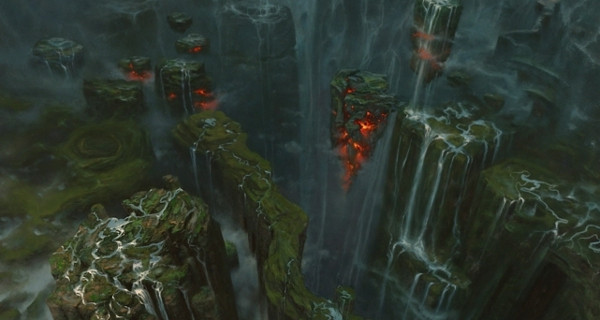



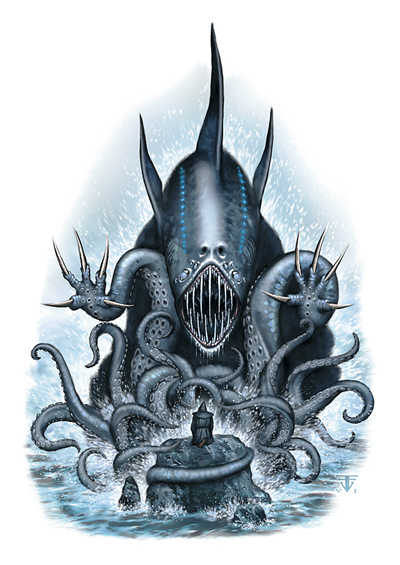
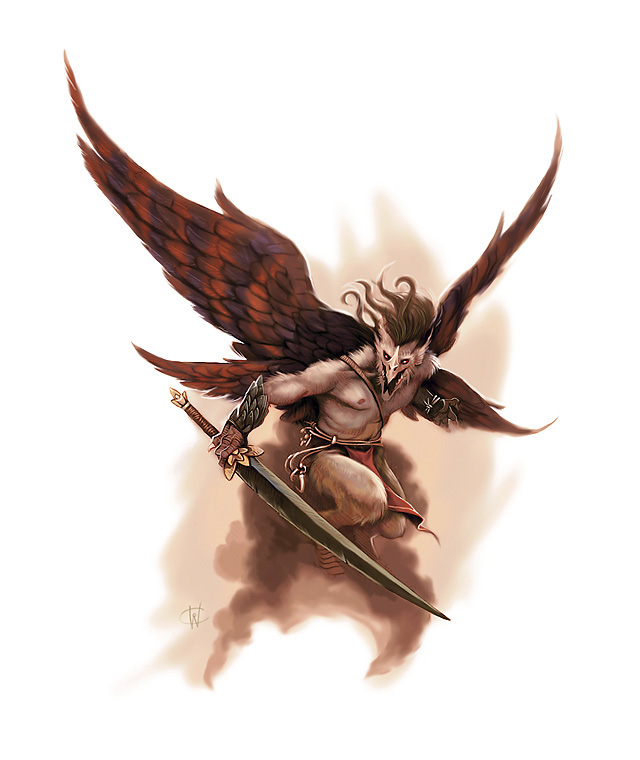
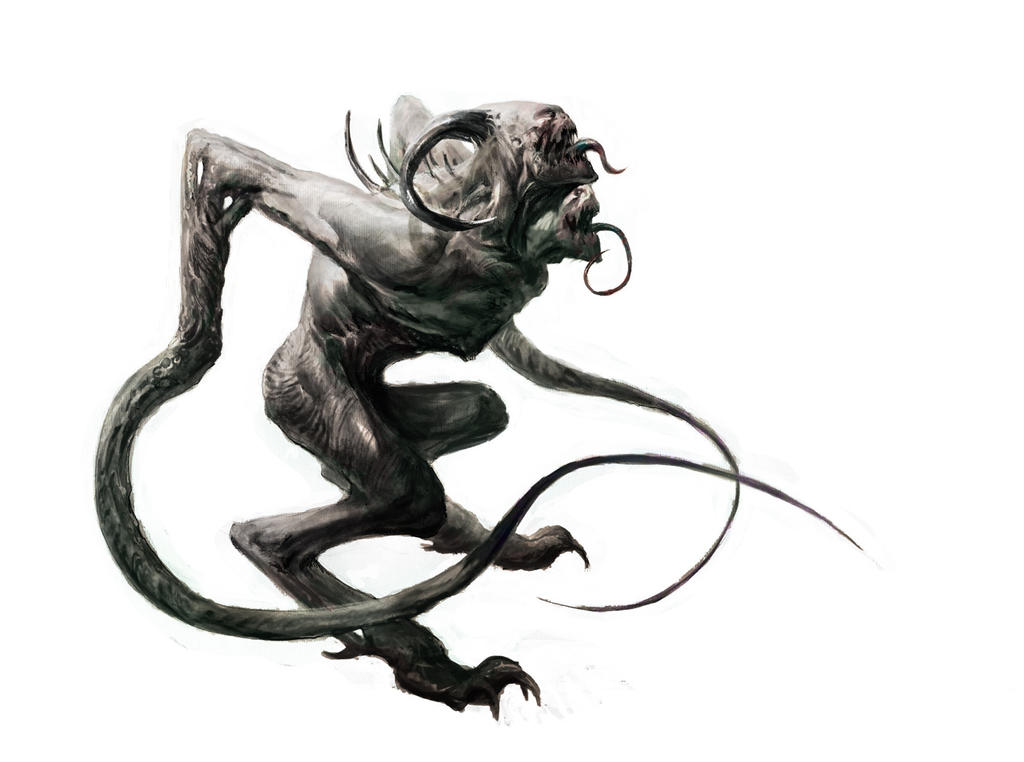



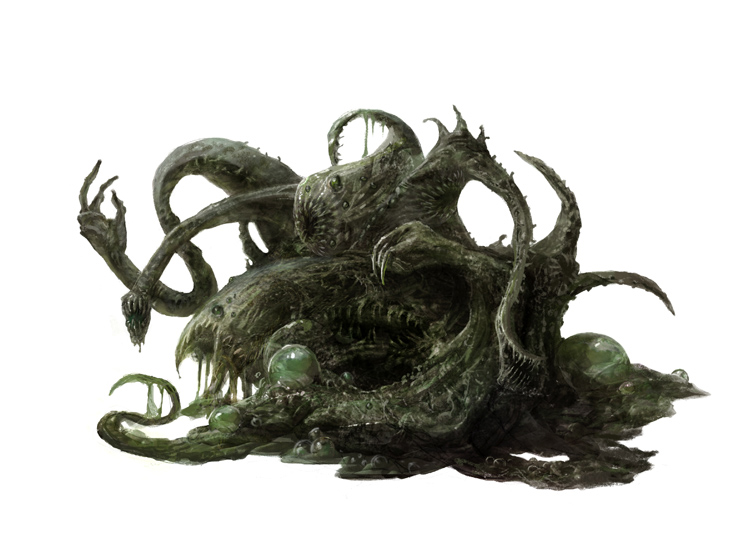



0 comments:
Post a Comment